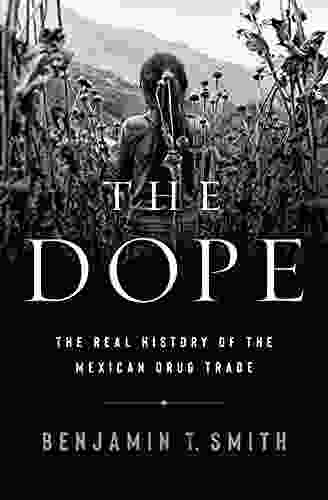The Real History of the Mexican Drug Trade: A Comprehensive Exposé

The Mexican drug trade has become a global phenomenon, with its roots deeply intertwined in the country's history and culture. Over the decades, it has evolved into a multi-billion dollar industry, fueled by insatiable demand for illicit substances in the United States and other parts of the world.
But how did the Mexican drug trade come to be? What are the key factors that have contributed to its growth and persistence? And what are the consequences of this illicit trade for Mexico and beyond?
4.4 out of 5
| Language | : | English |
| File size | : | 24869 KB |
| Text-to-Speech | : | Enabled |
| Screen Reader | : | Supported |
| Enhanced typesetting | : | Enabled |
| X-Ray | : | Enabled |
| Word Wise | : | Enabled |
| Print length | : | 468 pages |
Origins of the Mexican Drug Trade
The roots of the Mexican drug trade can be traced back to the early 20th century, when the country was engulfed in a bloody revolution. During this time, opium and morphine were widely used as pain relievers, and their production and distribution were largely unregulated.
In the 1930s, the Mexican government began to crack down on drug trafficking, but the trade continued to flourish, albeit in a more clandestine manner. The establishment of Prohibition in the United States in 1920 created a lucrative market for smuggled alcohol, and Mexican bootleggers quickly seized this opportunity.
As the demand for alcohol waned after the repeal of Prohibition in 1933, Mexican traffickers turned their attention to marijuana, which was becoming increasingly popular in the United States.
The Rise of the Cartels
In the 1970s and 1980s, the Mexican drug trade underwent a significant transformation, with the emergence of powerful cartels. These cartels, often led by ruthless and charismatic figures, controlled vast networks of production, distribution, and transportation.
The Guadalajara cartel, founded by Miguel Ángel Félix Gallardo in 1980, was one of the first major cartels to dominate the Mexican drug trade. Other powerful cartels that emerged during this period included the Tijuana cartel, the Juárez cartel, and the Sinaloa cartel.
The cartels engaged in fierce competition for control of territory and drug routes, leading to a wave of violence that plagued Mexico in the 1980s and 1990s.
The Drug War
In 2006, the Mexican government launched a major offensive against the drug cartels, known as the "war on drugs." This campaign has been marked by heavy-handed tactics, including the deployment of military forces and the arrest of numerous cartel leaders.
While the drug war has led to some successes, it has also been criticized for its high cost in terms of human life and social disruption. The violence associated with the drug trade has claimed the lives of tens of thousands of people in Mexico, including innocent bystanders, law enforcement officers, and cartel members.
The Impact of the Drug Trade
The Mexican drug trade has had a profound impact on the country's society, economy, and political landscape.
The violence associated with the drug trade has created a climate of fear and insecurity in many parts of Mexico. Entire towns and regions have been taken over by cartels, who have imposed their own brutal laws and terrorized local populations.
The drug trade has also fueled corruption at all levels of government. Corrupt officials have often turned a blind eye to the activities of cartels, or even colluded with them.
The drug trade has also had a negative impact on the Mexican economy. Illicit drug money has distorted markets and led to the growth of a shadow economy. The violence associated with the drug trade has also deterred foreign investment and tourism.
The Future of the Drug Trade
The future of the Mexican drug trade remains uncertain. Despite the government's ongoing efforts to combat the cartels, they continue to adapt and find new ways to operate. The demand for illicit drugs in the United States and other parts of the world remains high, and this demand is the lifeblood of the Mexican drug trade.
Some experts believe that the legalization of drugs in the United States could help to reduce the power of the Mexican cartels. However, others argue that legalization would simply create a new black market for drugs.
Solving the problem of the Mexican drug trade will require a multifaceted approach that addresses both supply and demand. It will require cooperation between Mexico and the United States, as well as other countries affected by the drug trade.
The real history of the Mexican drug trade is a complex and tragic tale. It is a story of greed, violence, and corruption. But it is also a story of resilience and hope. The Mexican people have shown great courage and determination in their fight against the drug trade, and they deserve our support.
4.4 out of 5
| Language | : | English |
| File size | : | 24869 KB |
| Text-to-Speech | : | Enabled |
| Screen Reader | : | Supported |
| Enhanced typesetting | : | Enabled |
| X-Ray | : | Enabled |
| Word Wise | : | Enabled |
| Print length | : | 468 pages |
Do you want to contribute by writing guest posts on this blog?
Please contact us and send us a resume of previous articles that you have written.
 Top Book
Top Book Novel
Novel Fiction
Fiction Nonfiction
Nonfiction Literature
Literature Paperback
Paperback Hardcover
Hardcover E-book
E-book Audiobook
Audiobook Bestseller
Bestseller Classic
Classic Mystery
Mystery Thriller
Thriller Romance
Romance Fantasy
Fantasy Science Fiction
Science Fiction Biography
Biography Memoir
Memoir Autobiography
Autobiography Poetry
Poetry Drama
Drama Historical Fiction
Historical Fiction Self-help
Self-help Young Adult
Young Adult Childrens Books
Childrens Books Graphic Novel
Graphic Novel Anthology
Anthology Series
Series Encyclopedia
Encyclopedia Reference
Reference Guidebook
Guidebook Textbook
Textbook Workbook
Workbook Journal
Journal Diary
Diary Manuscript
Manuscript Folio
Folio Pulp Fiction
Pulp Fiction Short Stories
Short Stories Fairy Tales
Fairy Tales Fables
Fables Mythology
Mythology Philosophy
Philosophy Religion
Religion Spirituality
Spirituality Essays
Essays Critique
Critique Commentary
Commentary Glossary
Glossary Bibliography
Bibliography Index
Index Table of Contents
Table of Contents Preface
Preface Introduction
Introduction Foreword
Foreword Afterword
Afterword Appendices
Appendices Annotations
Annotations Footnotes
Footnotes Epilogue
Epilogue Prologue
Prologue Mario Glowik
Mario Glowik Helen Baumann
Helen Baumann Hellen Heels
Hellen Heels Victor Johnson
Victor Johnson Edwin Felix
Edwin Felix Eric Chabot
Eric Chabot Santosh Ram
Santosh Ram Pamela Grundy
Pamela Grundy Marni Sommer
Marni Sommer Maggie Humm
Maggie Humm Donald Charles
Donald Charles Grace Lewis
Grace Lewis Alan Jackson
Alan Jackson Paul Tobin
Paul Tobin Jessie Ash
Jessie Ash Dr Edward Joseph
Dr Edward Joseph Joann Klusmeyer
Joann Klusmeyer Jeff Kass
Jeff Kass Flora Madison
Flora Madison K S Villoso
K S Villoso
Light bulbAdvertise smarter! Our strategic ad space ensures maximum exposure. Reserve your spot today!
 John MiltonFollow ·4.5k
John MiltonFollow ·4.5k Jerry HayesFollow ·16.6k
Jerry HayesFollow ·16.6k Alexander BlairFollow ·13.1k
Alexander BlairFollow ·13.1k Tennessee WilliamsFollow ·9k
Tennessee WilliamsFollow ·9k Octavio PazFollow ·14.6k
Octavio PazFollow ·14.6k Cooper BellFollow ·15.7k
Cooper BellFollow ·15.7k Harrison BlairFollow ·15.9k
Harrison BlairFollow ·15.9k José MartíFollow ·17.1k
José MartíFollow ·17.1k

 Ernest Powell
Ernest PowellBenefits of Corporal Punishment: A Review of the...
Corporal punishment is a form of physical...

 Bobby Howard
Bobby HowardThe Development and Significance of African American...
African American...

 Guy Powell
Guy PowellDown Girl: The Logic of Misogyny - A Comprehensive...
In her groundbreaking work,...

 Forrest Blair
Forrest BlairThe Bikini Changing Room: A Micro Mini Romance
In the heart of...
4.4 out of 5
| Language | : | English |
| File size | : | 24869 KB |
| Text-to-Speech | : | Enabled |
| Screen Reader | : | Supported |
| Enhanced typesetting | : | Enabled |
| X-Ray | : | Enabled |
| Word Wise | : | Enabled |
| Print length | : | 468 pages |
















